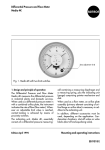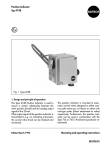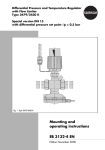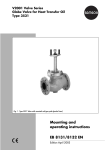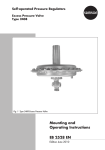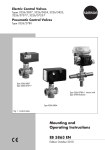Download Differential Pressure and Flowmeter Media 04
Transcript
Differential Pressure and Flowmeter Media 04 Fig. 1 ⋅ Media 04 1. Design and principle of operation The Media 04 Differential Pressure and Flowmeter is used for measuring the differential pressure in industrial plants and building services. When used in conjunction with an orifice plate as differential pressure pick-up, the instrument indicates the flow rate. Edition March 1993 The Media 04 Indicating Unit consists essentially of the differential pressure cell with measuring diaphragm and measuring spring, and the indicating unit with pointer mechanism and scale. For application as flowmeter in addition to the indicating instrument, an orifice plate assembly (orifice flange or orifice tube) is necessary. Mounting and operating instructions EB 9538 E 1 Differential pressure cell 1.1 1.2 1.3 1.4 1.5 1.6 1.7 1.8 Housing High pressure head Low pressure head Spring plate Measuring spring Measuring diaphragm Diaphragm plates Diaphragm shaft 1.9 1.10 1.11 1.12 1.13 1.14 1.15 1.16 Guide springs Connection link Lever Washer Washer(s) Screw O-ring Spring guide 2 Indicating unit 2.1 2.2 2.3 2.4 2.5 2.6 Rear cover Closing cover Regulating lever Gear mechanism Pointer Zero adjustment screw Fig. 2 ⋅ Top view section The differential pressure ∆p = p1 – p2 creates a force on the measuring diaphragm (1.6), which is balanced by the measuring spring (1.5). The deflection of the diaphragm (1.6) and the lever (1.11), which is proportional to 2 the differential pressure, is transferred from the pressure cell to the flexible washer (1.12) and is transmitted to the pointer mechanism via the adjusting lever (2.3). therefore, it must be kept to a minimum and must be considered when adjusting zero. The dimension “K” (compensating height, schematic 2) may be selected to suit the installation conditions. 2. Installation 2.1 Indicating unit At the point of installation, fasten the instrument to the pipe, wall or mounting plate free of vibrations. For mounting on a vertical or horizontal pipe, use the mounting device with clamp; for wall mounting, use mounting device without clamp (see dimension drawing, section 6). For panel-mounting (panel cut-out Ø114, hole circle Ø120 mm) unscrew closing cover and fasten rear cover with measuring cell to panel as shown in the dimension drawing on page 8. 2.2 Differential pressure lines The differential pressure lines should have tubes with an external Ø of 12 mm. The installation should be carried out according to Fig. 3. Proper arrangement is absolutely necessary. Pipe runs that would normally be installed horizontally should be mounted with a steady slope of not less than 1:20, i.e. sloping downward from the point that allows venting. The minimum bending radius shall not be less than 50 mm. Before the differential pressure lines are connected to the instrument they shall be flushed thoroughly. Make sure that the high-pressure line connects to the high-pressure connection and the low-pressure line to the low-pressure one. We recommend that both a shut-off valve and also an equalizing valve be installed in each differential pressure line. They are used to shut off the two differential pressure lines and short-circuit the lines at the indicating unit for checking zero. Attention: For connecting the differential pressure lines, cutting ring connections are necessary. Moreover, the free process fluid connections of the differential pressure cell must be closed by screw or vent plugs (see section 5). If the indicating unit is used for level measurement in vessels (Fig. 3), it must be arranged below the liquid level to be measured. The pressure line for the higher pressure must be connected to the high-pressure chamber of the indicating unit. In liquid level measurements according to the bottom left-hand schematic 1, the additional hight “z” is included in the measurement; M h z K = Measuring range = Measured height = Additional height = Compensating height z h H H H h h Shut-off valve Equalizing valve K - + Measurement on pressure vessels with condensating or non-condensating pressure cushion + - Measurement on open vessel with submerged ammeter + Measurement with cryogenic plants (liquefied gases) Fig. 3 ⋅ Installation schematics, e.g. liquid level measurement 3 2.3 Differential pressure pick-up (orifice flange or orifice tube for flow measurement) Before installing the differential pressure pick-up, make sure that the pipeline upstream and downstream of the standard orifice runs properly. For she straight part of pipeline behind the orifice a length of 5 D suffices (D is the internal pipe diameter). The required length of the straight pipe run upstream of the orifice depends on the aperture ratio “m” and should amount to approximately L = (130 m + 5) D. The aperture ratio m = d2 D2 4. Correcting zero If shut-off and equalizing valves are installed in the differential pressure lines, the zero point can also be checked when the system is being operated. First, close shut-off valve in the low-pressure line, then open equalizing valve and close shut-off valve in the high-pressure line. The pointer (2.5) must be positioned at zero. Otherwise, adjust the zero adjustment screw (2.6) until the zero position is reached. To place into service, first open the shut-off valve in the high-pressure line and then close the equalizing valve. Finally, open the shutoff valve in the low-pressure line. where d is the orifice diameter. The high-pressure tap is to be located upstream of the orifice whereas the low-pressure tap is to be downstream of the orifice. The sharp edge of the standard orifice must be on the orifice inlet side, directed against the medium flow (Fig. 4). The differential pressure lines (copper tube 12 x 1) are to be installed with a constant downward slope from the differential pressure pick-up. The indicating unit, therefore, should be arranged below the pipe to ensure that air inclusions can escape into the pipeline. + d _ D Fig. 4 ⋅ Orifice plate position 3. Start-up Check zero point prior to start-up. If necessary, correct it at the zero adjustment screw (2.6). Then slowly open the shut-off valves to fill the system, so that the air in the diaphragm chambers can escape. 4 4.2 Measuring span — measuring range The measuring span of the differential pressure flowmeter is determined by the differential pressure cell (three versions, different measuring diaphragms (1.6) and guide spring (1.9)) on the one hand, and by the measuring spring (1.5) installed on the other hand. The version of the measuring diaphragm and guide spring is printed on the name plate. The instrument is set by the manufacturer to the measuring range specified in the order, and the measuring range can be changed subsequently only within the range permitted by the measuring spring installed. The measuring span can be adjusted continuously up to 60 % of the maximum measuring span. When a different span is to be adjusted, the measuring spring (1.5) must be exchanged. See instrument name plate and the table on page 5. turning it counterclockwise and downward a little bit away from the center of motion of the toothed segment. Correct the zero point at the zero adjustment screw (2.6) and apply again full load to the measuring cell until the pointer shows 100 %. Check the upper measuring range value at the pressure gauge. Should it deviate from the desired measuring range, repeat adjustment procedure as described above until zero point and upper range value are correct. Should the measuring range be changed considerably, the zero point may drift out of its adjustment range. In this case, try to adjust the mid-value of the adjustment range by turning the zero adjustment screw. Then, remove pointer using a suitable pulling-off device and reinstall it on the shaft at the position “Zero”. 4.2.1 Adjusting and changing the measuring range (Figs. 2 and 5) Adjustment should preferably be made on the test bench. Unscrew the casing front section. Adjust zero point at zero adjustment screw (2.6). Apply a pressure to the high-pressure side of the measuring cell until the pointer indicates full scale output 100 %. Read off the pressure value at the checking pressure gauge (corresponds to the adjusted upper measuring range value); then remove pressure. If the measuring range is to be changed, the black adjusting lever (2.3) is to be displaced at the flattened point of the plastics part by turning it either clockwise or counterclockwise (see Fig. 5). If e.g. a wider measuring range is desired, the adjusting lever (2.3) is to be moved by Fig. 5 ⋅ Measuring range adjustment Measuring cell 1 Diaphragm 0.4/52 Guide spring 0.5 2 Diaphragm 0.4/70 Guide spring 0.8 3 Diaphragm 0.6/70 Guide spring 0.8 Measuring range (mbar) Measuring spring min. max. Wire-Ø mm Length ±0,1 mm Order-no. 0 to 40 0 to 60 0 to 100 0 to 160 0 to 250 0 to 400 0 to 60 0 to 100 0 to 160 0 to 250 0 to 400 0 to 600 1.2 1.2 1.8 2.25 2.5 2.8 34.4 32.7 32.2 32 31.9 31.7 1400-5871 1400-5872 1400-5873 1400-5874 1400-5875 1400-5876 0 to 250 0 to 400 0 to 600 0 to 1000 0 to 400 0 to 600 0 to 1000 0 to 1600 2.25 2.5 3 3.4 32.4 32.2 31.8 31.6 1400-5879 1400-5880 1400-5881 1400-5882 0 to 1600 0 to 2500 3.6 31.6 1400-5885 Part Designation Order-no. 1.13 1.15 Washers O-ring 22 x 2 — ECO 1400-5653 8421-0080 5 4.2.2 Changing the measuring range by exchanging the measuring spring (Figs. 2 and 6) Adjustment is to be made on the test bench only. If the measuring range is to exceed that of the built-in measuring spring, the measuring spring required shall be selected from the table on page 7. Only the springs suiting the existing measuring cell (see name plate) can be exchanged. Proceed as follows: Unscrew closing cover (2.2) and set zero point with adjusting screw (2.6). Loosen screws (1.14) and remove the spring plate (1.4), spring guide (1.16), measuring spring (1.5) and washer(s) (1.13) from the lowpressure side of the measuring cell. Install a new spring (1.5) and fasten spring plate with two screws (1.14). Check zero point, correct deviation by installing washers of different thickness (for oder number, see table on page 7). For this purpose, the spring plate must be removed each time. When zero point is obtained, screw on the spring plate firmly; check O-ring (1.15) for proper position and replace, if necessary. Adjust the measuring range as described in paragraph 4.2.1. Note on oxygen versions (O2) Instruments for oxygen measurement are provided with a label: Oxygen! Keep free from oil and grease! These versions have been assembled by the manufacturer under special conditions and have been washed afterwards. Use suitable gloves when exchanging parts which have contact with oxygen (e.g. measuring springs). 6 Fig. 6 ⋅ Measuring range spring 5. Connection accessories The instruments are delivered without process fluid connections. Required cutting ring connections, screw and vent plugs or throttles for damping of any oscillations caused by the measured medium (especially for gas measurement) must be ordered separately. Number Designation Order-no. Standard Rinsed for O2 2 Connections for tube 12 Ø, steel 1400-5842 1400-5843 2 Connections for tube 12 Ø, Niro 1400-5844 1400-5845 2 Connections for tube 10 Ø, steel 1400-5846 1400-5847 2 Connections for tube 8 Ø, steel 1400-5860 1400-5861 2 Connections for tube 12 Ø, with throttle, steel 1400-5848 1400-5849 2 Connections for tube 8 Ø, with throttle, steel 1400-5850 1400-5851 2 Connections for tube 6 Ø, with throttle, steel 1400-5852 1400-5853 2 Connections with throttle (special version for measurement of liquefied gas) — 1400-5858 2 Vent plugs, brass, with gaskets 1400-5654 1400-5658 2 Screw plugs, brass, with gaskets 1400-5655 1400-5659 1 Screw plug (half set), brass, with gasket 1400-5662 1400-5663 4 Gaskets 1400-5660 1400-5661 1 Mounting device for tube mounting 1400-5656 7 SAMSON AG ⋅ MESS- UND REGELTECHNIK Weismüllerstraße 3 ⋅ D-60314 Frankfurt am Main Postfach 10 19 01 ⋅ D-60019 Frankfurt am Main Telefon (0 69) 4 00 90 ⋅ Telefax (0 69) 4 00 95 07 EB 9538 E S/C 08.94 6. Dimensions in mm








